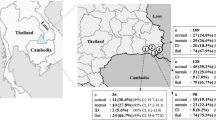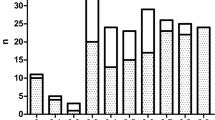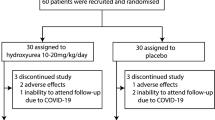Abstract
THE A2 fraction of normal haemoglobin (Hb-A2) has been described by Kunkel and Wallenius in 19551 and soon after it was confirmed that this fraction doubled its normal values or reached even greater concentrations in β-thalas-saemia minor2, and it has been found to be increased in pernicious anaemia in relapse3, in patients with Hb-Zürich4, in recipients of foetal haemopoietic tissue5 and in a single case of hereditary spherocytosis6. It is easy to exclude the last four conditions, and so greater concentrations of Hb-A2 than normal are considered specific for the diagnosis of β-thalassaemia minor.
This is a preview of subscription content, access via your institution
Access options
Subscribe to this journal
Receive 51 print issues and online access
$199.00 per year
only $3.90 per issue
Buy this article
- Purchase on Springer Link
- Instant access to full article PDF
Prices may be subject to local taxes which are calculated during checkout
Similar content being viewed by others
References
Kunkel, H. G., and Wallenius, G., Science, 122, 288 (1955).
Kunkel, H. G., Ceppellini, R., Müller-Eberhard, U., and Wolf, J., J. Clin. Invest., 36, 1615 (1957).
Josephson, A. M., Masri, M. S., Singer, L., Dworkin, D., and Singer, K., Blood, 13, 543 (1958).
Rieder, R. F., Zinkham, W. H., and Holtzman, N. A., Amer. J. Med., 39, 4 (1965).
Bridges, J. M., Neill, D. W., and Lehmann, H., Brit. Med. J., 1, 1349 (1961).
Harmeling, J. G., and Moquin, R. B., Amer. J. Clin. Pathol., 47, 454 (1967).
Arends, T., Proc. Eighth Intern. Cong. Hematol., 1214 (Tokyo, 1960).
Williams, H. U., Arch. Pathol., 7, 839 (1929).
Cabannes, R., Bourrier, A., and Larrouy, G., Nouv. Rev. Franç. d'Hémat., 5, 617 (1965).
Houchin, D. H., and Robinette, R. W., Lancet, i, 155 (1959).
Betke, K., Marti, H. R., and Schilicht, I., Nature, 184, 1877 (1959).
Singer, K., Chernoff, A. L., and Singer, L., Blood, 6, 413 (1951).
Burchenal, J. R., Cancer Res., 26, 2393 (1966).
Allison, A. C., Brit. Med. J., 1, 290 (1954).
Lehmann, H., in Abnormal Haemoglobins (edit. by Jonxis, T. J. H., and Delafresnaye, J. F.), 202 (Blackwell, Oxford, 1959).
Evans, J. V., Blunt, M. H., and Southcott, W. H., Austral. J. Agric. Res., 14, 549 (1963).
Arends, T., and Gallango, M. L., Brit. J. Haematol., 11, 350 (1965).
Gallango, M. L., and Arends, T., Acta Genet., 16, 162 (1966).
Author information
Authors and Affiliations
Rights and permissions
About this article
Cite this article
ARENDS, T. High Concentrations of Haemoglobin A2 in Malaria Patients. Nature 215, 1517–1518 (1967). https://doi.org/10.1038/2151517a0
Received:
Revised:
Issue Date:
DOI: https://doi.org/10.1038/2151517a0
Comments
By submitting a comment you agree to abide by our Terms and Community Guidelines. If you find something abusive or that does not comply with our terms or guidelines please flag it as inappropriate.



